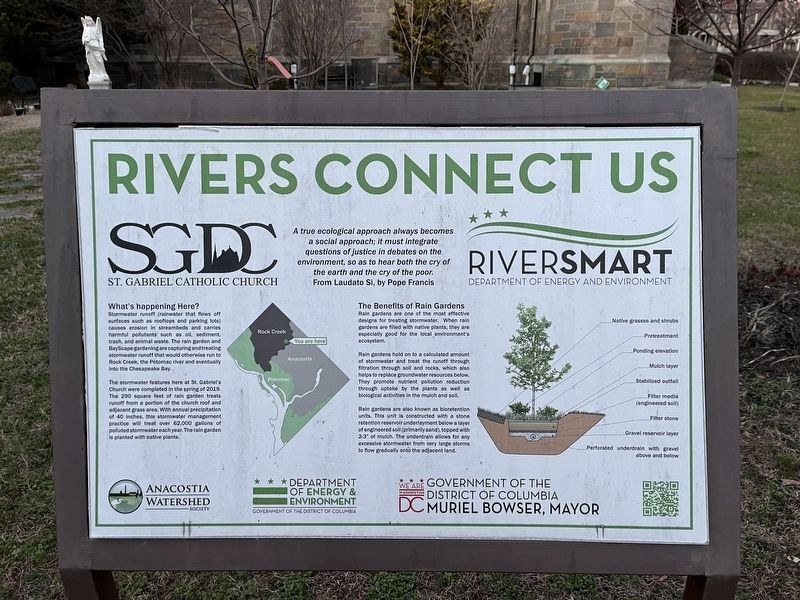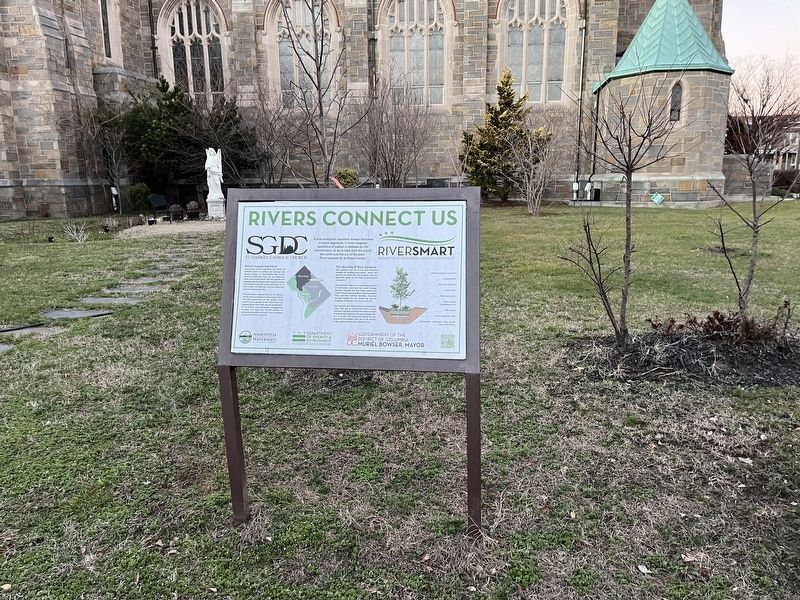Petworth in Northwest Washington in Washington, District of Columbia — The American Northeast (Mid-Atlantic)
Rivers Connect Us
St. Gabriel Catholic Church
A true ecological approach always becomes a social approach; it must integrate questions of justice in debates on the environment, so as to hear both the cry of the earth and the cry of the poor.
From Laudato Si, by Pope Francis
What's happening Here?
Stormwater runoff (rainwater that flows off surfaces such as rooftops and parking lots) causes erosion in streambeds and carries harmful pollutants such as oil, sediment, trash, and animal waste. The rain garden and BayScape gardening are capturing and treating stormwater runoff that would otherwise run to Rock Creek, the Potomac river and eventually into the Chesapeake Bay.
The stormwater features here at St. Gabriel's Church were completed in the spring of 2019. The 290 square feet of rain garden treats runoff from a portion of the church roof and adjacent grass area. With annual precipitation of 40 inches, this stormwater management practice will treat over 62,000 gallons of polluted stormwater each year. The rain garden is planted with native plants.
The Benefits of Rain Gardens
Rain gardens are one of the most effective designs for treating stormwater. When rain gardens are filled with native plants, they are especially good for the local environment's ecosystem.
Rain gardens hold on to a calculated amount of stormwater and treat the runoff through filtration through soil and rocks, which also helps replace groundwater resources below. They promote nutrient pollution reduction through uptake by the plants as well as biological activities in the mulch and soil.
Rain gardens are also known as bioretention units. This unit is constructed with a stone retention reservoir underlayment below a layer of engineered soil (primarily sand), topped with 2-3" of mulch. The underdrain allows for any excessive stormwater from very large storms to flow gradually onto the adjacent land.
Erected by DC Department of Environment, Government of the District of Columbia, Mural Bowser, Mayor; Anacostia Watershed Society; St. Gabriel Catholic Church.
Topics. This historical marker is listed in these topic lists: Churches & Religion • Environment • Waterways & Vessels. A significant historical year for this entry is 2019.
Location. 38° 56.605′ N, 77° 1.203′ W. Marker is in Northwest Washington in Washington, District of Columbia. It is in Petworth. Marker is at the intersection of Grant Circle Northwest and Varnum Street Northwest, on the right when traveling west on Grant Circle Northwest. Touch for map. Marker is at or near this postal address: 26 Grant Cir NW, Washington DC 20011, United States of America. Touch for directions.
Other nearby markers. At least 8 other markers
Additional commentary.
1. About the marker
This sign serves as a historical marker because it demonstrates how this community has made a choice in addressing concerns of environmental stewardship. It shares at length how, why and when it worked on this project.
— Submitted February 3, 2024, by Devry Becker Jones of Washington, District of Columbia.
Credits. This page was last revised on February 3, 2024. It was originally submitted on February 3, 2024, by Devry Becker Jones of Washington, District of Columbia. This page has been viewed 48 times since then. Photos: 1, 2. submitted on February 3, 2024, by Devry Becker Jones of Washington, District of Columbia.

